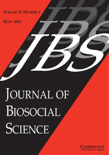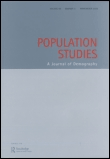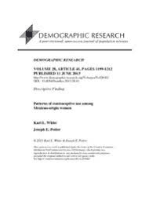
European Journal of Population-Revue Europeenne de Demographie
Scope & Guideline
Illuminating Population Dynamics Across Europe
Introduction
Aims and Scopes
- Demographic Dynamics and Family Structures:
The journal investigates family formation, dissolution, and transitions, examining how these dynamics are influenced by socioeconomic factors, cultural contexts, and policy frameworks. - Migration and Mobility Studies:
A significant focus is placed on migration patterns, including the impact of migration on family structures, fertility rates, and integration processes in host societies. - Health and Mortality Analysis:
Research on health disparities and mortality trends forms a core area, with studies often analyzing the effects of socioeconomic status, ethnicity, and geographic factors on health outcomes. - Fertility and Reproductive Behavior:
The journal extensively covers fertility trends, intentions, and behaviors, exploring how economic conditions, educational attainment, and social norms shape reproductive choices. - Socioeconomic Inequalities and Demographic Outcomes:
There is a consistent examination of how inequalities in resources, education, and employment influence demographic behaviors, particularly in relation to family life and childbearing. - Interdisciplinary Approaches to Population Studies:
The journal promotes interdisciplinary methodologies, integrating insights from sociology, economics, public health, and policy analysis to address complex demographic issues.
Trending and Emerging
- Impact of Economic Crises on Demographics:
There is a growing emphasis on understanding how economic downturns, such as the COVID-19 pandemic and other crises, affect fertility intentions, family dynamics, and migration patterns. - Intersectionality in Family and Migration Studies:
Emerging research increasingly addresses intersectional factors, such as gender, ethnicity, and socioeconomic status, in understanding population dynamics and family structures. - Digitalization and Remote Work Effects on Family Life:
The rise of remote work and digital communication is becoming a focal point of research, exploring its implications for family formation, parenting, and demographic behaviors. - Health Disparities and Population Well-Being:
There is an intensified interest in the links between health outcomes and demographic variables, particularly in the context of social inequalities and access to healthcare. - Sustainability and Population Policies:
Research is increasingly examining the implications of demographic trends for sustainability, including the environmental impact of population growth and family policies. - Diversity in Family Structures:
The journal is seeing a rise in studies that explore diverse family forms, including cohabitation, same-sex partnerships, and non-traditional parenting arrangements.
Declining or Waning
- Traditional Marriage and Childbearing Norms:
Research focusing on conventional marriage patterns and childbearing norms has seen a decline, as societal shifts towards more diverse family structures and cohabitation arrangements become more prevalent. - Rural Demographic Studies:
There has been a noticeable decrease in studies concentrating on rural demographic issues, as urbanization and migration trends draw more attention in demographic research. - Single-Factor Analyses of Fertility:
The journal has moved away from single-factor analyses of fertility, transitioning towards more complex, multifaceted approaches that consider the interplay of various social, economic, and cultural factors. - Static Models of Population Dynamics:
There is a diminishing focus on static demographic models, with a shift towards dynamic models that better capture the complexities of population changes over time. - Historical Demography:
Historical demographic studies, while still relevant, appear to be less frequent in recent publications, suggesting a shift towards contemporary and future-oriented demographic research.
Similar Journals

JOURNAL OF BIOSOCIAL SCIENCE
Innovating Understanding of Health in Social ContextsJOURNAL OF BIOSOCIAL SCIENCE, published by Cambridge University Press, is a pivotal interdisciplinary journal dedicated to advancing our understanding of the complex interplay between biological and social factors in human health and society. With an ISSN of 0021-9320 and an E-ISSN of 1469-7599, this journal has been a cornerstone of scholarly communication since its inception in 1969, paving the way for innovative research until 2024 and beyond. The journal is ranked in the Q3 quartile in Public Health, Environmental and Occupational Health and Q2 in Social Sciences (miscellaneous), reflecting its significant impact in these fields. Its Scopus ranking further emphasizes its relevance, sitting at #79 out of 275 in General Social Sciences and #334 out of 665 in Public Health. Researchers, professionals, and students are encouraged to explore the journal's rich repository of articles that delve into critical biosocial issues, fostering a deeper understanding of how social structures influence health and well-being. Although not open access, the journal remains an essential resource for those committed to addressing contemporary health challenges through a biosocial lens.

Comparative Population Studies
Exploring the intricacies of population trends worldwide.Comparative Population Studies is an esteemed open-access journal published by the BUNDESINSTITUT BEVOELKERUNGSFORSCHUNG in Germany, dedicated to advancing the field of demography. Since its launch and transition to open access in 2010, the journal has provided a platform for researchers to share innovative population studies, promoting a deeper understanding of demographic trends and patterns globally. With an impressive Q2 rank in Demography within the 2023 quartile categories and a commendable rank #61 out of 139 in Scopus' Social Sciences Demography classification, it plays a vital role in disseminating rigorous research. The journal covers a range of topics related to population dynamics, migration, and social implications, making it invaluable to academics, professionals, and students in the field. With an emphasis on comparative studies, Comparative Population Studies not only fosters scholarly dialogue but also enhances policy-making and economic planning. Located at Friedrich-Ebert-Allee 4, Wiesbaden 65185, Germany, the journal continues to be a prominent resource for those eager to engage with the latest demographic research.

POPULATION STUDIES-A JOURNAL OF DEMOGRAPHY
Pioneering Research in Demography and Historical AnalysisPopulation Studies: A Journal of Demography is an esteemed scholarly publication dedicated to advancing the understanding of demographic trends and their historical contexts. Published by Routledge Journals, Taylor & Francis Ltd, this journal has a notable impact in its field, recognized as a Q1 category journal in both Demography and History as of 2023. Its Scopus rankings highlight its significance, featuring a remarkable 12th place rank in Arts and Humanities—History and 19th place in Social Sciences—Demography, both underscoring its influential role in academic research. Established in 1947, the journal has consistently contributed to the discourse in population studies, offering a platform for innovative research and critical analysis. While it does not provide open access options, it remains a vital resource for researchers, professionals, and students who seek to explore the complex relationships between population dynamics and historical narratives. Its comprehensive coverage from 1947 to 2024 ensures a rich repository of knowledge, making it essential for anyone involved in demographic research.

Revista Latinoamericana de Poblacion
Exploring the Dynamics of Latin American PopulationsRevista Latinoamericana de Poblacion is a distinguished open-access journal dedicated to the field of population studies, published by the Asociación Latinoamericana de Población. Since its inception in 2007, the journal has aimed to foster scholarly dialogue and disseminate critical research on demographic dynamics across Latin America. With an emphasis on diverse methodologies and interdisciplinary approaches, the journal serves as a platform for researchers, professionals, and students to engage with pressing issues such as migration, fertility, aging, and socio-economic factors influencing population trends. As an invaluable resource for the academic community, this journal not only promotes accessibility to vital research through its open-access model but also plays a crucial role in enhancing the understanding of demographic changes and their implications in the region. By focusing on the unique context of Latin America, Revista Latinoamericana de Poblacion facilitates a deeper insight into population phenomena that resonate globally.

Demographic Research
Transforming data into actionable demographic knowledge.Demographic Research is a leading journal in the field of demography, published by the prestigious Max Planck Institute for Demographic Research. Available in both print and electronic formats (ISSN: 1435-9871, E-ISSN: 1435-9871), this open-access journal has been a valuable resource for demographers and social scientists since its inception in 1999. With a commendable impact factor and ranked Q1 in its category, the journal demonstrates a significant commitment to advancing our understanding of demographic trends and their implications across contexts. Hailing from Germany, the journal's rich international perspective adds depth to its studies, making it a vital platform for innovative research. Researchers, professionals, and students are encouraged to engage with its wealth of articles that not only document demographic changes but also offer insights critical for policy-making and social planning. The journal's broad scope encompasses diverse themes, providing a comprehensive overview of the demographic shifts that shape societies today.

Ager-Revista de Estudios sobre Despoblacion y Desarrollo Rural
Championing Open Access to Rural StudiesAger-Revista de Estudios sobre Despoblacion y Desarrollo Rural, published by PRENSAS UNIV ZARAGOZA, is a distinguished academic journal focused on the critical fields of demography, rural development, and geography. With an ISSN of 1578-7168 and E-ISSN of 2340-4655, this journal serves as a vital resource for researchers, professionals, and students dedicated to understanding the dynamics of population decline and sustainable development in rural areas. The journal has gained recognition for its quality, evidenced by its placement in the Q3 category across multiple domains in the 2023 rankings, including Demography, Development, and Geography, Planning and Development. Additionally, it holds impressive Scopus ranks, notably at 48th percentile in Demography and 78th percentile in Anthropology. With contributions from eminent scholars and practitioners, Ager not only disseminates high-quality research but also nurtures discourse on policy implications and innovative solutions for rural challenges. The journal is open access, fostering broad accessibility and encouraging scholarly dialogue in the critical study of population and rural development. Whether you are a seasoned researcher or an emerging scholar in the field, Ager provides a platform for impactful insights and collaboration in tackling pressing rural socio-economic issues.

Central and Eastern European Migration Review
Navigating the Complexities of Migration in Central and Eastern EuropeThe Central and Eastern European Migration Review, published by the CENTRE MIGRATION RESEARCH, University of Warsaw, serves as a critical platform for sharing innovative research on migration dynamics within Central and Eastern Europe. This Open Access journal has been a vital resource for scholars since its inception in 2012, enabling widespread access to high-quality research that addresses pressing demographic, social, and political issues related to migration. With an impressive ranking among the Q2 category in Demography, Social Sciences (miscellaneous), and Sociology and Political Science, it occupies a significant space in contemporary sociological discourse, reflecting its robust scholarly impact. Notably, the journal achieved Scopus rankings that place it in the 60th percentile or higher within multiple categories, highlighting its contributions to the field. Researchers, professionals, and students alike can delve into a diverse array of articles that explore migration trends, policies, and societal implications, making it an indispensable resource for anyone engaged in migration studies.

Journal of Demographic Economics
Unlocking the Potential of Population Trends for Economic GrowthThe Journal of Demographic Economics, published by Cambridge University Press, stands as a leading interdisciplinary platform dedicated to the exploration and advancement of research in the intertwined fields of demography, economics, and geography. With an impact factor that reflects its esteemed position—ranking in the Q1 quartile for Demography (2023)—the journal fosters scholarly dialogue through high-quality articles that elucidate the complex interactions between population dynamics and economic trends. Operating under an open access model, the journal ensures that its findings are widely accessible, promoting inclusivity and engagement among researchers, professionals, and students alike. The Journal of Demographic Economics endeavors to bridge gaps in knowledge by publishing innovative and rigorous studies, thereby contributing significantly to both theoretical frameworks and practical applications across various domains. Drawing submissions from a global audience, this journal not only enhances the understanding of demographic transitions but also informs policy decisions and socioeconomic development strategies, making it an essential resource for those invested in demographic and economic research.

JOURNAL OF POPULATION RESEARCH
Advancing demographic insights for a changing world.JOURNAL OF POPULATION RESEARCH, published by Springer, is a premier journal dedicated to advancing the field of demographic studies. With a focus on research that addresses the complexities of population dynamics, this journal serves as a vital platform for scholars, practitioners, and students alike. It holds a commendable Q2 ranking in the Demography category for 2023, underscoring its influence and commitment to quality research. The journal spans a rich convergence of knowledge from 2005 to 2024, covering key developments and emerging trends in population research. Although it operates under a traditional access model, its impact continues to resonate throughout the academic community, highlighting the importance of robust demographic analysis in policy and planning. By fostering insightful discussions and providing access to groundbreaking studies, the JOURNAL OF POPULATION RESEARCH remains an essential resource for those eager to deepen their understanding of population issues.

Canadian Studies in Population
Uncovering the Trends that Define CanadaCanadian Studies in Population, published by Springer, is a prestigious journal dedicated to advancing the field of demography and the history of population studies within Canada and beyond. With an ISSN of 0380-1489 and an E-ISSN of 1927-629X, this journal has proudly contributed to scholarly discourse since its inception in 1975, and continues to make significant impacts through its rigorous research articles and comprehensive reviews. Recognized for its high academic standards, it boasts a Q2 ranking in Demography and a Q1 ranking in History in 2023, reflecting the journal's critical role in shaping contemporary understanding of demographic trends and historical population developments. With a Scopus rank of #51/139 in Demography and #83/1760 in History, it appeals to a diverse audience including researchers, professionals, and students eager to explore population dynamics, historical context, and societal implications of demographic shifts. While the journal maintains traditional subscription access options, its rigorous peer-reviewed content ensures that it remains a cornerstone for scholars seeking credible and influential insights in their respective fields.